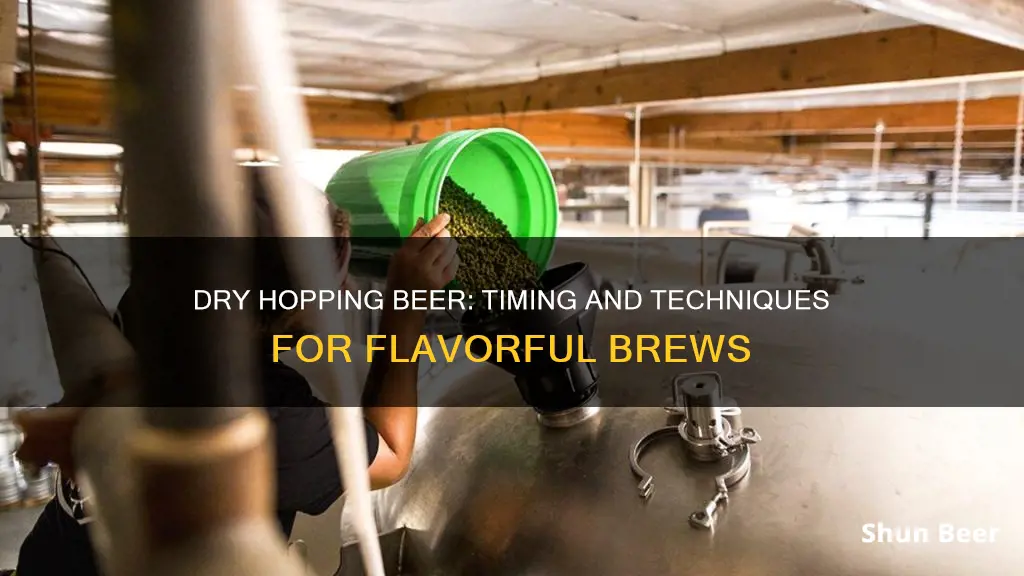
Dry hopping is the process of adding hops to beer after primary fermentation, usually during or right after it has finished. The purpose of dry hopping is to add aroma and flavour to the beer without imparting any bitterness. Hops contain alpha acids which, when heated during the boil, undergo isomerisation and provide hop bitterness. However, dry hopping preserves the delicate volatile oils that produce flavour and aroma, giving the beer a mouth-watering aroma. The hops can be added in the primary or secondary fermenter, or directly to a keg. The timing of dry hopping depends on the desired aroma and flavour profile of the final product.
| Characteristics | Values |
|---|---|
| What is dry hopping? | The process of adding hops (dried whole leaf or T-90 pellets) during or right after primary fermentation. |
| Purpose | To add aroma and flavour without imparting bitterness to the beer. |
| When to dry hop? | During or after primary fermentation, or in the keg. |
| How long to dry hop? | 24 hours minimum, ideally 48-72 hours. |
| Hops type | Aroma hops or flavour hops. |
| Hops form | Pellet, plugs, loose, or whole cone hops. |
| Amount of hops | 1-2 oz. for a five-gallon batch, but can go up to 4 oz. or even more. |
| Use of bags | Muslin or cheesecloth bags can be used to contain the hops, but this may reduce their exposure to the beer. |
| Dry hopping under pressure | Can be done to lock in volatile aromas and combat oxidation. |
What You'll Learn

Dry hopping with whole leaf vs pellets
Dry hopping is the process of adding hops (either dried whole leaf or T-90 pellets) during or right after primary fermentation. This process adds aroma and flavour without any additional bitterness to your beer.
Whole Leaf vs Pellets
You can use both pellet and whole leaf hops for dry hopping. Pellet hops are more convenient and readily available. Leaf hops, on the other hand, take up more space in the fermenter and soak up more beer, reducing the overall yield. Commercial breweries tend to use pellet hops because of their longer shelf life, efficiency, and reduced beer absorption. Pellet hops will also sink in the beer, while leaf hops will float on top of the liquid.
Whole hops are the most natural, unprocessed form of hops. They can form a filter bed when straining the boiled wort, removing some of the hot break and other material formed during the mash and boil. Some brewers also believe that whole hops produce less harsh flavours than pellets, although there is no empirical evidence to support this claim.
Whole hops are ideal for dry hopping because they are minimally processed, so more of the volatile aromatic compounds remain intact. They also won't sink and block your siphoning efforts when it's time to bottle your beer. However, whole hops have a smaller surface area, which means it takes longer to extract and use the alpha acids, resulting in lower hop utilisation.
Pellet hops, on the other hand, have a clear surface area advantage due to their ability to sink and dissolve. This advantage is further enhanced by the ruptured lupulin glands, which make it easier to isomerise the alpha acids and increase utilisation. Pellets are also easier to measure, work with, and store, and they result in less beer loss.
However, the extra processing of pellet hops can negatively affect the aromatic quality. The ruptured lupulin glands cause a loss of essential oils, which would otherwise be slowly released by the whole lupulin glands, allowing time for some oxidation of hydrocarbons.
Hops in Beer: Vegetable or Not?
You may want to see also

The history of dry hopping
After the ban was lifted, the use of hops became widespread, with brewers adding them to the boil or using the dry hopping technique. By the 1800s, hopped beer surpassed gruit in popularity, and brewers continued to dry hop to create aroma instead of bitterness. The term "dry hopping" refers to the addition of dry hops directly into the fermented ale, although they do get wet in the process.
The practice of dry hopping has evolved, and today, brewers use different methods and types of hops to achieve specific flavours and aromas in their beers. The most common method involves siphoning fermented beer into a secondary fermenter and adding hops for flavour shortly before bottling or canning. Brewers can use whole cone hops, which float, or pelletized hops, which sink, depending on their preferences and goals.
Dry hopping is a versatile technique that has been adopted by the industry to flavour beverages beyond beer, including cider, showcasing the enduring appeal of the process that originated with Hildegard's ale in medieval Germany.
The Historical Addition of Hops to Beer
You may want to see also

Choosing the right hops
- Aroma-forward hops are generally recommended for dry hopping as they contribute more flavour and aroma without adding bitterness. Look for hops with relatively low alpha acid ratings, often around 6% or less. Examples include Cascade, Crystal, Willamette, East Kent Golding, Fuggle, Saaz, Hallertau, and Tettnanger.
- Consider the type of beer you are brewing. For example, if you are brewing a West Coast/American IPA, hops like Cascade, Centennial, Amarillo, and Simcoe may be good choices. For tropical NEIPAs, Citra, Mosaic, and Galaxy hops can add a nice tropical fruit character.
- Experiment with different hop varieties to find what you like. If you enjoy the results of a particular hop variety added during the last 5-10 minutes of the boil, you may also like the results when dry hopping with the same variety.
- Pay attention to the alpha acid content of the hops. Hops with higher alpha acids tend to have a lower percentage of delicate aroma oils, so using lower alpha acid hops can be more efficient for dry hopping. However, higher alpha acid hops can still provide great results.
- Try blending different hops to add complexity to your beer. You can mix and match hops used in similar styles of beer or complement each other aromatically.
- If you are dry hopping during active fermentation, consider the potential for biotransformation, where chemical reactions between the yeast and hops can enhance flavours and aromas, leading to different tropical flavours in your IPAs.
- Don't be afraid to experiment and trust your instincts. The "right" hops are ultimately the ones that appeal to your taste preferences and help you achieve the desired flavour profile for your beer.
Blue Moon Beer: Hops or No Hops?
You may want to see also

When to add hops
Dry hopping is the process of adding hops to your beer after primary fermentation. This can be done during or right after primary fermentation has finished. The purpose of dry hopping is to add aroma and flavour to your beer without increasing bitterness.
There are several options for when to add hops during the dry-hopping process. The first is during primary fermentation. This is a more advanced technique as it can be difficult to avoid extracting unwanted bitter oils and compounds into your beer. However, it is possible to add hops during this stage and it is a method used by some brewers.
The second option is to add hops after primary fermentation. This is a good option as the vigorous CO2 activity of the primary fermentation is finished, so the aroma of the hops won't be lost from the beer.
The third option is to add hops after secondary fermentation. This is considered the best time to dry hop as the beer has mostly fermented so the alcohol and low pH help to prevent any bacterial growth on the hops.
The final option is to add hops directly to the keg. This can be done loose or in a muslin or cheesecloth bag to prevent hops from being sucked into the system. However, some brewers feel that leaving hops in the beer for too long can give it a "grassy" flavour.
In terms of how long to dry hop for, 24 hours will impart some aroma, but 48 to 72 hours is the ideal period. Any longer and you risk losing essential oils and aromas, and may encounter "hop creep", which can affect the quality of your beer.
Stout Beers: Hops, Their Presence and Purpose
You may want to see also

How long to dry hop for
The ideal period for dry hopping is anywhere between 24 hours and 72 hours. If you're impatient and want to know if your method works, 24 hours is enough to get some aroma in your beer. However, the longer you dry hop, the more aroma you will get. But dry hopping for longer than 72 hours will not only stop you from extracting important essential oils and aromas but you also risk hop creep, which can affect the quality of your beer.
Some brewers say that adding hops early means the CO2 will scrub off many of the flavours and aromas. Others say that leaving hops too long can add grassy flavours. Some also say that adding hops during active fermentation will promote biotransformation, which changes and enhances the hop flavours. This can lead to different tropical flavours in your IPAs.
If you're dry hopping in a secondary fermenter, you may want to add more hops than you would for dry hopping in a primary or keg. This is because the bubbling of the CO2 and the agitation of the wort during primary fermentation can take some of the hop aroma out of the beer.
If you're using a bag to dry hop, you may want to use 10-15% more hops when bagging as the hops tend to expand when wet, reducing the hops' exposure to the beer.
Scottish Beers: More Hops or Just a Myth?
You may want to see also
Frequently asked questions
Dry hopping is the process of adding hops to beer after primary fermentation. It adds aroma and flavour without bitterness.
The timing depends on the type of beer and your personal preference. You can dry hop after primary or secondary fermentation, or even in the keg. For a traditional approach, dry hop after secondary fermentation. For New England IPAs, dry hop during active fermentation.
The ideal duration for dry hopping is 48 to 72 hours. Longer than this and you risk losing essential oils and aromas, and you may encounter "hop creep", which affects beer quality.
You can use whole leaf or pellet hops for dry hopping. Pellet hops are more convenient and readily available, but leaf hops can give a traditional character to your brew.
You can add hops directly to the fermenter or use a hop bag for easier removal. If using pellet hops, a bag is recommended to avoid excess hop matter in your final product.







